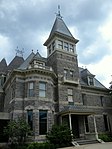Greystone station
Former New York Central Railroad stationsMetro-North Railroad stations in New York (state)New York (state) railway station stubsRailway stations in Westchester County, New YorkRailway stations in the United States opened in 1899 ... and 1 more
Transportation in Yonkers, New York

Greystone station is a commuter rail stop on the Metro-North Railroad's Hudson Line, located in the Greystone neighborhood of Yonkers, New York. It is the northernmost station on the Hudson Line in Yonkers. North and Southbound trains leave the station at about every hour. The station is 17.1 miles (27.5 km) from Grand Central Terminal and travel time to Grand Central is about 50 minutes. As of August 2006, daily commuter ridership was 513 and there are 250 parking spots.
Excerpt from the Wikipedia article Greystone station (License: CC BY-SA 3.0, Authors, Images).Greystone station
Harriman Avenue, City of Yonkers
Geographical coordinates (GPS) Address Nearby Places Show on map
Geographical coordinates (GPS)
| Latitude | Longitude |
|---|---|
| N 40.9721 ° | E -73.8896 ° |
Address
Harriman Avenue 55
10701 City of Yonkers
New York, United States
Open on Google Maps






